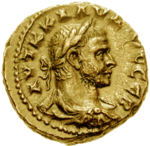Wikipedia:WikiProject Numismatics/newsletter/October 2019

|
The WikiProject Numismatics newsletter |
|---|---|
| Issue VII | |
Article of the Month[edit]
The Mercury dime is a ten-cent coin struck by the United States Mint from late 1916 to 1945. Designed by Adolph Weinman and also referred to as the Winged Liberty Head dime, it gained its common name because the obverse depiction of a young Liberty, identifiable by her winged Phrygian cap, was confused with the Roman god Mercury. Weinman is believed to have used Elsie Stevens, the wife of lawyer and poet Wallace Stevens, as a model. The coin's reverse depicts a fasces, symbolizing unity and strength, and an olive branch, signifying peace.
By 1916, the dime, quarter, and half dollar designed by Mint Chief Engraver Charles E. Barber had been struck for 25 years, and could be replaced by the Treasury, of which the Mint is a part, without Congressional authorization. Mint officials were under the misapprehension that the designs had to be changed, and held a competition among three sculptors, in which Barber, who had been in his position for 36 years, also took part. Weinman's designs for the dime and half dollar were selected.
Although the new coin's design was admired for its beauty, the Mint made modifications to it upon learning that vending machine manufacturers were having difficulties making the new dime work in their devices. The coin continued to be minted until 1945, when the Treasury ordered that a new design, featuring recently deceased president Franklin Roosevelt, take its place. The Mercury dime was minted again but in gold for its centenary in 2016. (Full article...)
News[edit]
Project[edit]
- The WikiProject's first cross-wiki contest, focused on importing and uploading images of Unites States banknotes to Wikimedia Commons, will begin on November 1 and end on December 31. The goal of the contest will be to increase the number of high quality US banknote images available to content creators on all Wikimedia projects. A notification will be sent to project members when the signup period starts.
Content[edit]
Good articles
Other[edit]
- Old Spanish Trail half dollar (discussion) is under review for Featured Article status.
- PLENTY (currency) (discussion) has been nominated for deletion.
Miscellaneous[edit]
- The newsletter has been redesigned. If you have any comments, questions, or suggestions, please leave them here.
On the Main Page[edit]
Today's Featured Article[edit]
| September 26 |
|
The Louisiana Purchase Sesquicentennial half dollar was a proposed United States commemorative coin. Intended for the 150th anniversary of the Louisiana Purchase (shown in white), the coin was sought by both the Missouri Historical Society (MHS) and the Louisiana Purchase 150th Anniversary Association of New Orleans, led by Clay Shaw; they hoped to be able to buy the entire coin issue from the government and sell it at a profit. Numismatist Eric P. Newman advocated for the bill on behalf of the MHS. The House of Representatives passed authorizing legislation in April 1953, but the Senate was slow to act, passing it in January 1954. The Treasury Department strongly opposed the bill, and President Dwight D. Eisenhower vetoed it and two other commemorative coin bills on February 3, 1954; Congress made no attempt to override the vetoes. No commemorative coins were authorized or issued by the United States after 1954 until a new issue was struck in 1982. (Full article...) |
Picture of the Day[edit]
September 7
 |
The Cuban peso is one of two official currencies in use in Cuba, the other being the convertible peso. Most Cuban state workers receive their wages in national pesos, but some receive a portion of their salary in convertible pesos. Shops that sell basic necessities, such as groceries, generally accept only national pesos, whereas convertible pesos are much more commonplace in "dollar shops", which sell non-essential commodities and goods. The word "peso" may refer to either currency.
This picture shows a five-peso coin, dated 1915, containing on average 8.3592 grams (0.29486 oz) of gold (.900 fine), depicting José Martí on the obverse and the coat of arms of Cuba on the reverse. The coin was engraved by Chief Engraver of the United States Mint Charles E. Barber and struck at the Philadelphia Mint. |
September 16
 |
The Iranian toman is a superunit of the official currency of Iran, the rial. One toman is equivalent to ten rials. Although the rial is the official currency, Iranians use the toman in everyday life.
This picture shows a ten-toman gold coin dated AH 1314 (c. 1896), depicting Mozaffar ad-Din, shah of the Qajar dynasty, on the obverse. |
Did You Know...[edit]
- ... that in some Polish homes, an image of a Jew holding a coin (example pictured) hangs to the left of the doorway, and is customarily turned upside down on the Sabbath so that good fortune may fall upon the household? (September 3)
- ... that Ziyad ibn Abi Sufyan (dirhams pictured), the first governor of a unified Iraqi province, restarted the Muslim conquests in Khurasan? (September 16)
- ... that a monumental euro-sign sculpture (pictured) is installed at the Willy-Brandt-Platz in Frankfurt, which was named in 1992 after the former chancellor? (September 30)
New members are added to the subscriber list • If you are not a member and would like to receive this newsletter, or are a member but would not like to receive future issues, you may subscribe/unsubscribe here




